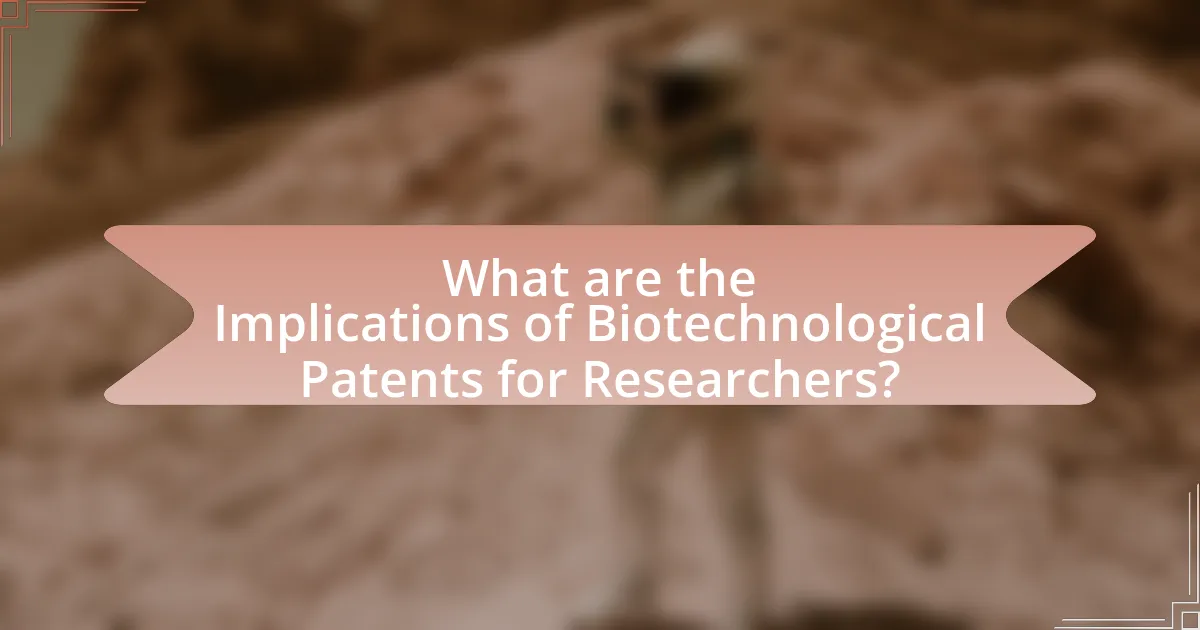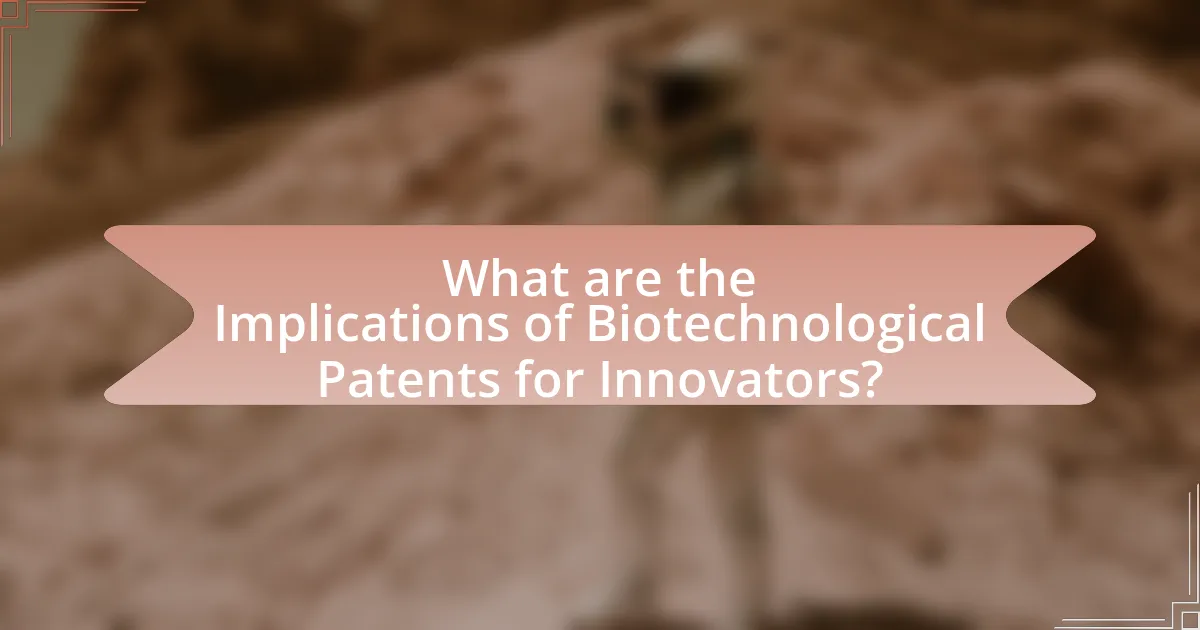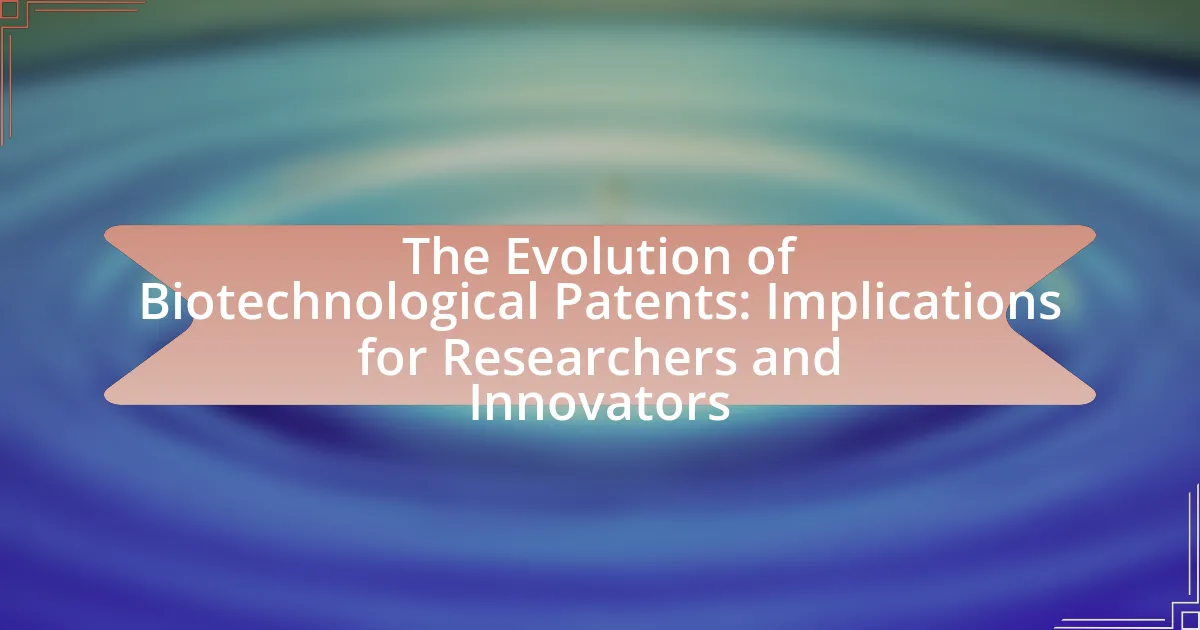Biotechnological patents are legal protections for inventions in biotechnology, encompassing processes, products, and technologies derived from biological systems. This article examines the significance of these patents in fostering innovation, particularly in healthcare, agriculture, and environmental sustainability. It highlights the differences between biotechnological and traditional patents, the historical context of patent evolution, and landmark legal cases that have shaped patent law. Additionally, the article discusses current trends in biotechnological patents, the implications for researchers and innovators, and the ethical considerations surrounding access to biotechnological advancements. It concludes with best practices for navigating the complexities of patent landscapes in the biotechnology sector.

What are Biotechnological Patents and Their Importance?
Biotechnological patents are legal protections granted for inventions in the field of biotechnology, which includes processes, products, and technologies derived from biological systems. These patents are crucial because they incentivize innovation by providing inventors exclusive rights to their discoveries for a specified period, typically 20 years. This exclusivity encourages investment in research and development, leading to advancements in healthcare, agriculture, and environmental sustainability. For instance, the patenting of genetically modified organisms has spurred significant agricultural innovations, enhancing crop yields and resistance to pests. Thus, biotechnological patents play a vital role in fostering innovation and ensuring that inventors can reap the financial benefits of their work.
How do biotechnological patents differ from traditional patents?
Biotechnological patents differ from traditional patents primarily in their subject matter, as they often encompass living organisms, genetic materials, and biological processes, which are not typically covered by conventional patents. Traditional patents usually protect inventions that are mechanical or chemical in nature, focusing on tangible products or processes. In contrast, biotechnological patents must navigate complex ethical and legal considerations, such as the patentability of naturally occurring substances and the implications of genetic manipulation. For instance, the U.S. Supreme Court’s decision in Association for Molecular Pathology v. Myriad Genetics, Inc. (2013) established that naturally occurring DNA sequences cannot be patented, highlighting the unique challenges faced in the biotechnology sector.
What specific innovations are covered under biotechnological patents?
Biotechnological patents cover specific innovations such as genetically modified organisms (GMOs), biopharmaceuticals, and novel methods for genetic engineering. These patents protect inventions that involve the manipulation of biological systems or organisms to create new products or processes. For instance, the patenting of GMOs allows companies to secure exclusive rights over crops that have been altered for traits like pest resistance or increased yield, as seen in the widespread patenting of Bt corn. Additionally, biopharmaceutical patents protect innovative drugs developed through biotechnological processes, such as monoclonal antibodies, which have revolutionized treatments for various diseases. The legal framework surrounding these patents ensures that inventors can benefit from their innovations while promoting further research and development in the biotechnology sector.
Why is the distinction between biotechnological and traditional patents significant?
The distinction between biotechnological and traditional patents is significant because it affects the scope of protection, regulatory requirements, and the commercialization process of inventions. Biotechnological patents often involve living organisms or biological processes, which require compliance with specific regulations, such as those set by the U.S. Patent and Trademark Office and the European Patent Office, that differ from traditional patents covering mechanical or chemical inventions. This regulatory complexity can influence the investment decisions of researchers and innovators, as the pathway to obtaining and enforcing biotechnological patents may be more challenging and costly compared to traditional patents.
What historical context led to the evolution of biotechnological patents?
The historical context that led to the evolution of biotechnological patents includes the rise of molecular biology and genetic engineering in the mid-20th century. The discovery of DNA’s structure in 1953 and subsequent advancements in recombinant DNA technology during the 1970s prompted the need for legal frameworks to protect biotechnological inventions. The U.S. Supreme Court’s 1980 decision in Diamond v. Chakrabarty established that genetically modified organisms could be patented, marking a significant shift in patent law. This ruling, along with the Bayh-Dole Act of 1980, which allowed universities and small businesses to patent inventions developed with federal funding, further accelerated the commercialization of biotechnological innovations. These developments created a legal environment that encouraged investment and research in biotechnology, leading to the establishment of a robust patent system in the field.
How have landmark cases shaped biotechnological patent law?
Landmark cases have significantly shaped biotechnological patent law by establishing key legal precedents that define what can be patented in the field. For instance, the Supreme Court’s decision in Diamond v. Chakrabarty (1980) allowed for the patenting of genetically modified organisms, affirming that living organisms could be considered patentable subject matter under U.S. law. This ruling opened the door for numerous patents on biotechnological inventions, influencing the commercialization of genetic engineering and biotechnology research. Additionally, the case of Mayo Collaborative Services v. Prometheus Laboratories (2012) clarified the limits of patenting natural laws and correlations, emphasizing that patents must involve an inventive concept beyond mere application of natural phenomena. These cases collectively have shaped the landscape of biotechnological patent law, guiding researchers and innovators in understanding the boundaries of patentability and fostering an environment for innovation while also raising ethical considerations.
What role did technological advancements play in patent evolution?
Technological advancements significantly influenced patent evolution by enabling the creation of new inventions and refining the processes for their protection. Innovations in fields such as biotechnology, information technology, and materials science have led to a surge in patent applications, reflecting the need to safeguard novel ideas and products. For instance, the introduction of genetic engineering techniques in the 1970s prompted the establishment of specific patent laws to address the unique challenges posed by biotechnological inventions, such as the patentability of living organisms. This evolution in patent law has been documented in various legal cases and legislative changes, demonstrating how advancements in technology necessitate corresponding adaptations in intellectual property frameworks to ensure adequate protection for inventors and promote further innovation.
What are the current trends in biotechnological patents?
Current trends in biotechnological patents include a significant increase in applications related to CRISPR technology, personalized medicine, and synthetic biology. The rise of CRISPR has led to a surge in patent filings, with over 1,000 patents related to gene editing technologies filed globally since its inception. Additionally, the focus on personalized medicine has resulted in patents that cover genetic testing and tailored therapies, reflecting a shift towards individualized healthcare solutions. Synthetic biology is also gaining traction, with patents being filed for engineered organisms and novel biological systems, indicating a growing interest in bio-manufacturing and sustainable practices. These trends highlight the dynamic nature of the biotechnology sector and its ongoing evolution in response to scientific advancements and market demands.
How are emerging technologies influencing patent applications?
Emerging technologies are significantly influencing patent applications by increasing the complexity and scope of inventions eligible for protection. For instance, advancements in artificial intelligence, biotechnology, and nanotechnology have led to novel inventions that challenge traditional patent criteria, such as novelty and non-obviousness. According to the World Intellectual Property Organization (WIPO), the number of patent applications in biotechnology has surged, reflecting the rapid pace of innovation in this field. This trend necessitates that patent offices adapt their examination processes to accommodate the unique characteristics of these technologies, ensuring that they remain relevant and effective in protecting intellectual property.
What are the implications of global patent harmonization for biotechnological innovations?
Global patent harmonization significantly impacts biotechnological innovations by creating a unified legal framework that simplifies the patent application process across different jurisdictions. This harmonization reduces the complexity and costs associated with obtaining patents in multiple countries, thereby encouraging more investment in biotechnological research and development. For instance, according to a study by the World Intellectual Property Organization, harmonized patent systems can lead to a 20% increase in innovation output by streamlining the protection of intellectual property. Furthermore, it fosters collaboration among researchers and companies globally, as standardized patent laws facilitate easier sharing of technologies and knowledge.

What are the Implications of Biotechnological Patents for Researchers?
Biotechnological patents significantly impact researchers by influencing access to innovations and shaping the direction of scientific inquiry. These patents can restrict researchers’ ability to freely use patented materials and methods, often requiring licensing agreements that can be costly and time-consuming. For instance, a study published in the journal Nature Biotechnology highlighted that patenting practices can lead to a “patent thicket,” where overlapping patents create barriers to research and development, ultimately hindering innovation. Additionally, the presence of patents can shift research priorities towards commercially viable projects rather than fundamental scientific exploration, as researchers may focus on areas with clearer pathways to patentable outcomes.
How do biotechnological patents affect research funding and collaboration?
Biotechnological patents significantly influence research funding and collaboration by creating a framework that incentivizes investment and partnership among stakeholders. These patents provide exclusive rights to inventors, which can attract funding from private investors and venture capitalists who seek to capitalize on patented innovations. For instance, a study published in the journal “Nature Biotechnology” found that institutions holding strong patent portfolios were more likely to secure funding, as investors perceive these patents as a safeguard against competition and a means to ensure potential returns on investment.
Moreover, biotechnological patents can facilitate collaboration between academia and industry by establishing clear ownership and usage rights, which encourages joint ventures and research agreements. According to research by the National Bureau of Economic Research, collaborations that involve patented technologies often lead to increased funding opportunities, as companies are more willing to invest in projects with defined intellectual property protections. Thus, biotechnological patents play a crucial role in shaping the landscape of research funding and collaborative efforts in the biotechnology sector.
What challenges do researchers face in navigating patent landscapes?
Researchers face significant challenges in navigating patent landscapes, primarily due to the complexity and variability of patent laws across different jurisdictions. The intricate nature of patent claims can lead to difficulties in determining the scope of protection, which is essential for avoiding infringement. Additionally, the sheer volume of patents in biotechnological fields complicates the identification of relevant prior art, making it challenging for researchers to assess the novelty of their innovations. Furthermore, the rapid pace of technological advancement often results in overlapping patents, creating a landscape where freedom to operate becomes increasingly uncertain. These challenges are compounded by the need for researchers to balance innovation with compliance, as missteps in navigating patent landscapes can lead to costly legal disputes or hindered research progress.
How can researchers leverage patents to enhance their work?
Researchers can leverage patents to enhance their work by utilizing them as a source of technical information and inspiration for innovation. Patents provide detailed descriptions of inventions, including methodologies and experimental results, which can inform researchers about existing technologies and gaps in the market. For instance, a study published in the journal “Nature Biotechnology” highlights that analyzing patent databases can reveal trends in biotechnological advancements, allowing researchers to identify areas for further exploration and development. Additionally, patents can serve as a foundation for building new inventions, as researchers can improve upon patented technologies or develop novel applications, thereby fostering innovation in their respective fields.
What ethical considerations arise from biotechnological patents?
Biotechnological patents raise several ethical considerations, primarily concerning access to genetic resources, the commodification of life forms, and the potential for monopolization of essential medical treatments. Access to genetic resources can lead to inequities, as patenting may restrict availability for research and development, particularly in developing countries. The commodification of life forms raises moral questions about ownership and the implications of treating living organisms as property. Additionally, monopolization can result in high costs for patented treatments, limiting patient access and raising concerns about the prioritization of profit over public health. These ethical issues highlight the need for a balanced approach to patenting that considers both innovation and societal welfare.
How do patents impact access to biotechnological advancements?
Patents significantly restrict access to biotechnological advancements by granting exclusive rights to inventors, which can limit the availability of innovations to the public. When a company or individual holds a patent, they can control the production, use, and distribution of the patented technology, often leading to higher costs and reduced accessibility for researchers and innovators. For instance, a study published in the journal “Nature Biotechnology” highlights that patenting can create barriers for follow-on research, as researchers may face licensing fees or restrictions that hinder their ability to build upon existing technologies. This exclusivity can stifle competition and slow down the pace of innovation in the biotechnology sector.
What are the implications for public health and safety?
The implications for public health and safety regarding the evolution of biotechnological patents are significant, as these patents can influence access to essential medical innovations and treatments. When biotechnological inventions are patented, it can lead to monopolies that restrict the availability of life-saving therapies, particularly in low-income regions. For instance, the patenting of genetically modified organisms and pharmaceuticals can result in higher prices, limiting access for patients who need these innovations for treatment. Additionally, the regulatory environment surrounding biotechnological patents can impact the speed at which new therapies are developed and brought to market, affecting public health outcomes. Studies have shown that patent protections can both incentivize innovation and create barriers to access, highlighting the need for balanced policies that promote both innovation and public health equity.

What are the Implications of Biotechnological Patents for Innovators?
Biotechnological patents significantly impact innovators by providing exclusive rights to their inventions, which can enhance market competitiveness and encourage investment in research and development. These patents allow innovators to secure financial returns on their investments, as they can prevent others from using their patented technologies without permission. For instance, the U.S. Supreme Court’s decision in Association for Molecular Pathology v. Myriad Genetics, Inc. (2013) clarified that naturally occurring genes cannot be patented, influencing how innovators approach genetic research and development. This legal framework shapes the landscape of biotechnological innovation, as it balances the need for protection of intellectual property with the public interest in access to biotechnological advancements.
How can innovators protect their inventions through patents?
Innovators can protect their inventions through patents by filing a patent application with the relevant patent office, which grants them exclusive rights to their inventions for a specified period. This process involves documenting the invention in detail, including its functionality and uniqueness, and demonstrating that it meets the criteria of novelty, non-obviousness, and usefulness. According to the United States Patent and Trademark Office, a patent can prevent others from making, using, or selling the invention without permission, thereby providing a legal framework for innovators to safeguard their intellectual property and potentially monetize their inventions.
What strategies can innovators use to navigate the patent application process?
Innovators can navigate the patent application process by conducting thorough prior art searches, drafting comprehensive patent claims, and seeking professional legal assistance. Conducting prior art searches helps innovators identify existing patents and publications that may affect their application, ensuring originality and relevance. Drafting comprehensive claims is crucial as it defines the scope of protection sought, and clear, detailed claims can significantly enhance the chances of approval. Seeking professional legal assistance from patent attorneys or agents can provide expertise in navigating complex legal requirements and improving the quality of the application, which is supported by the fact that applications prepared by professionals often have higher success rates in securing patents.
How do patents influence market competition in biotechnology?
Patents significantly influence market competition in biotechnology by granting exclusive rights to inventors, which can lead to monopolistic practices. This exclusivity allows patent holders to control pricing and market access for their innovations, often resulting in higher costs for consumers and limiting competition from other firms. For instance, a study by the National Bureau of Economic Research found that patented biopharmaceuticals can lead to prices that are 50% higher than their generic counterparts, illustrating how patents can restrict market entry and competition. Additionally, patents can incentivize investment in research and development, as companies are more likely to invest in innovative biotechnologies when they can secure a competitive edge through patent protection.
What are the potential risks associated with biotechnological patents?
The potential risks associated with biotechnological patents include hindering innovation, restricting access to essential technologies, and creating legal disputes. These patents can limit researchers’ ability to explore and develop new solutions due to exclusive rights granted to patent holders, which may stifle collaborative efforts. Additionally, high licensing fees can prevent smaller companies and researchers from accessing critical biotechnological advancements, ultimately affecting public health and scientific progress. Legal disputes often arise over patent infringement, leading to costly litigation and uncertainty in the research community, which can further delay advancements in biotechnology.
How can patent infringement affect innovators and their businesses?
Patent infringement can significantly hinder innovators and their businesses by imposing legal and financial burdens. When a patent is infringed, the innovator may face costly litigation, which can drain resources and divert attention from research and development. According to a study by the National Bureau of Economic Research, companies involved in patent litigation can experience a 20% decrease in stock value, reflecting the financial instability that arises from such disputes. Additionally, the threat of infringement can deter investment, as potential investors may view the associated risks as too high. This creates a challenging environment for innovators, ultimately stifling innovation and slowing the advancement of new technologies in the biotechnological field.
What are the consequences of patent expiration for innovators?
Patent expiration leads to increased competition and reduced market exclusivity for innovators. Once a patent expires, other companies can produce and sell generic versions of the patented product, which often results in a significant drop in sales and profits for the original innovator. For instance, the expiration of the patent for the drug Lipitor in 2011 allowed generic manufacturers to enter the market, leading to a rapid decline in sales for Pfizer, the original patent holder. Additionally, innovators may face challenges in recouping their research and development investments, as the influx of generic alternatives typically drives prices down. This dynamic can discourage future innovation, as the potential for financial returns diminishes when patents expire.
What best practices should researchers and innovators follow regarding biotechnological patents?
Researchers and innovators should conduct thorough prior art searches to identify existing patents and literature before filing for biotechnological patents. This practice minimizes the risk of infringing on existing patents and helps in crafting unique claims. Additionally, they should ensure that their inventions meet the criteria of novelty, non-obviousness, and utility, as these are fundamental requirements for patentability.
Furthermore, maintaining detailed and accurate records of research and development processes is essential, as this documentation can support patent applications and defend against potential disputes. Engaging with patent attorneys who specialize in biotechnology can provide valuable insights into navigating complex patent laws and regulations.
Lastly, researchers and innovators should stay informed about changes in patent laws and trends in biotechnology to adapt their strategies accordingly, ensuring their intellectual property remains protected and relevant in a rapidly evolving field.


